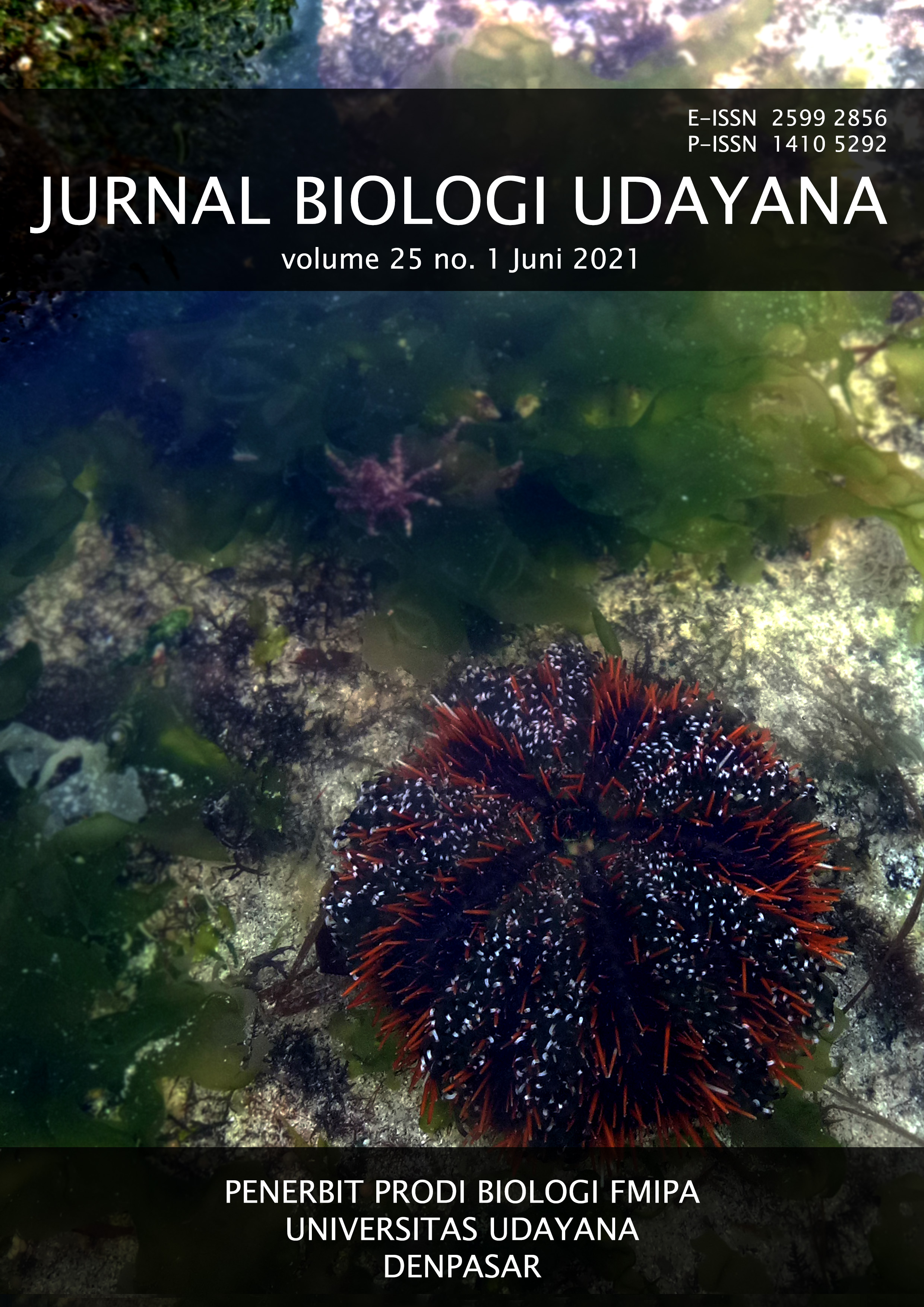Arthropods diversity on pea’s field in Kupang Regency East Nusa Tenggara Province
Abstract
The success of pea’s cultivation is influenced by the presence of arthropods that act as pollinators, decomposers, parasitoids and bioindicators. This research aimed at determining the diversity of arthropods on pea’s farming lands in Kupang district. This research was a descriptive quantitative research that had been carried out in three locations, namely peanut farming field, long bean farming field, and green bean farming field. Arthropod samples were taken by using pitfall traps, insect nets, and hand sorting. The results showed that arthropod diversity varied in the three pea’s farming lands. First, on peanut farming land, 31 species, 15 families, 9 orders, 2 classes were found, with a total of 115 individuals. Second, on the long bean farming land, 17 species, 11 families, 7 orders, 2 classes were found, with a total of 53 individuals. Last, there were 30 species, 20 families, 9 orders, 3 classes, with a total of 108 individuals found in green bean farming land. The highest diversity index was found in green bean farming land at 3.19, followed by peanut farming land at 2.83, and long bean farming land at 2.43. The highest species richness index value was found in peanut farming land at 6.32, followed by green bean farming land at 6.19, and the lowest in long bean farming land at 4.03. There was no arthropod species that dominated in the three peanut farming lands, the species were classified as evenly distributed. The similarity between Jaccard and peanut habitats showed a value less than 50%, meaning that the similarity level of the arthropod family found in the three pea habitats was low. The low level of similarity could be caused by the application of pesticides, especially in long beans and green beans farming lands. Furthermore, abiotic factors had a significant effect on arthropod diversity.
Downloads
References
Amin A, Ibrohim I, Tuarita H. 2016. Studi keanekaragaman Arthropoda pada lahan pertanian tumpangsari untuk inventarisasi predator pengendalian hayati di Kecamatan Bumiaji Kota Batu. Jurnal Pertanian Tropik 3(2): 139-149
Annam AC, Khasanah N. 2017. Keanekaragaman Arthropoda pada pertanaman kubis (Brassica oleracea L.) yang diaplikasi insektisida kimia dan nabati. Agrotekbis 5(3): 308-314.
Ardillah JS, Leksono AS, Hakim L. 2014. Diversitas Arhropoda tanah di area restorasi Ranu Pani Kabupaten Lumajang. Biotropika: Journal of Tropica Biology 2(4): 208-213.
Bazelet CS, Samways MJ. 2011. Identifying grasshopper bioindicators for habitat quality assessment of ecological networks. Ecological Indikator 11(5): 1259-1269.
Borror D, Triplehorn CA, Johnson NF. 1992. Pengenalan Pelajaran Serangga Edisi Keenam. Universitas Gadjah Mada: Yogyakarta.
Culliney WT. 2013. Review: Role of Arthropods in Maintaining Soil Fertility. Agriculture 3: 629-659.
Elhayati N, Hariri AM, Wibowo L, Fitriana Y. 2017. Keanekaragaman Arthropoda permukaan tanah pada pertanaman ubi kayu (Manihot utilissima Pohl.) setelah perlakuan olah tanam dan pengelolaan gulma. J. Argotek Tropika 5(3):158-164.
Esenowo IK, Akpabio EE, Adeyemi-Ale OA, Okoh VS. 2014. Evaluation of arthropod diversity and abundance in contrasting habitat, uyo, akwa ibom state, Nigeria. J. Appl. Sci. Environ. Manage 18(3): 403-408.
Haneda N, Kusmana C, Kusuma F. 2013. Keanekaragaman serangga di ekosistem mangrove. Jurnal Silvikultur Tropika, 4(1): 42-46.
Harist A, Wawan, Wardati. 2017. Sifat fisik tanah dan pertumbuhan tanaman karet (Hevea brasiliensis Muell. Arg) pada beberapa kondisi penutupan lahan dengan Mucuna bracteata. JOM Faperta UR 4(2):1-14.
Kumar H, Usmani MK. 2014. Taxonomic studies on Acrididae (Orthoptera: Acridoidea) from Rajasthan (India). Journal of Entomology and Zoology Studies 2(3): 131-146.
Ludwig JA, Reynolds JF. 1988. Statistical Ecology: A Primer methods and computing. JohnWiley & Sons: New York.
Magurran AE. 2004. Measuring Biological Diversity. Blackwell Science Ltd
More SV, Nikam KN. 2016. Studies grasshoppers (orthoptera) in tilari forest, Chandgad, Kolhapur district of Maharashtra (India). International Journal of Recent Scientific Research (IJRSR) 7(3): 9457-9460.
Muli R, Irsan C, Suheryanto. 2015. Komunitas Athropoda tanah di kawasan sumur minyak bumi di desa Mangunjaya, kecamatan Babat Toman, kabupaten Musi Banyuasin, provinsi Sumatera Selatan. Jurnal Ilmu Lingkungan 13(1): 1-11.
Parmar TK, Rawtani D, Agrawal YK. 2016. Bioindicators: the natural indicator of environmental pollution. Frontiers in Life Science 9(2): 110-118.
Prakoso, B. 2017. Biodiversitas belalang (acrididae: ordo orthoptera) pada agroekosistem (Zea mays L.) dan ekosistem hutan tanaman di Kebun Raya Baturaden, Banyumas. Biosfera 34( 2): 80-88.
Riyanto. 2007. Kepadatan, pola distribusi dan peranan semut pada tanaman di sekitar lingkungan tempat tinggal. Jurnal Penelitian Sains 10(2): 241-253.
Ruchin BA, Mikhailenko PA. 2018. Fauna of mantids and orthopterans (Insecta: Mantodea, Orthoptera) of the Mordovia State Reserve, Russia. Biodiversitas 19(4): 1194-1206.
Seino RA, Njoya MTM. 2018. Species diversity of pyrgomorphidae (orthoptera: caelifera) grasshoppers in the north west region of Cameroon. International Journal of Zoology and Applied Biosciences 3(1): 104-109.
Semiun CG, Mamulak YI. 2019. Keanekaragaman jenis belalang (Ordo Orthoptera) di pertanian kacang hijau (Vigna radiate L.) desa Manusak kabupaten Kupang. Stigma 12(2): 66-70.
Semun CG, Lengur ERA, Duhan GUUB. 2020. Insect diversity profile of mangrove ecosystem in Menipo Nature Tourism Park, East Amarasi, East Nusa Tenggara. IOP Conference Series: Materials Science and Engineering 823: 1-9.
Semiun CG, Stanis S. 2016. Kelimpahan dan keanekaragaman Arthropoda tanah pada lahan pertanian monokultur dan polikultur di desa Labat Kupang. BioWallacea Jurnal Ilmiah Ilmu Biologi 2(3): 154-161.
Sierwald P, Bond JE. 2007. Current Status of the Myriapod Class Diplopoda (Millipedes): Taxonomic Diversity and Phylogeny. Annual Review of Entomology 52(1): 401–420.
Sugiarto A. 2018. Inventarisasi belalang (Orthoptera: Acrididae) di perkebunan dan persawahan Desa Serdang Menang, Kecamatan Sirah Pulau Padang, Kabupaten Ogan Komering Ilir.Insect Village 1(3): 7-10.
Suin MN. 2012. Ekologi Hewan Tanah. Bandung: Bumi Aksara.
Zayadi H, Hakim L, Leksono AS. 2013. Composition and diversity of soil arthropods of Rajagwesi Meru Betiri Natinal Park. The Journal of Tropical Life Science 3(3): 166-171.








